2. 重庆市农业资源与环境研究重点实验室, 重庆 400716
2. Chongqing Key Laboratory of Agricultural Resources and Environment, Chongqing 400716, China
邻苯二甲酸酯(phthalate esters, PAEs)又称酞酸酯, 是一类典型的环境激素类污染物, 通常被作为增塑剂广泛地用于塑料制品、橡胶产品, 也作为农药载体、化妆品、润滑剂和去泡剂的生产原料大量使用, 近些年, 越来越多的PAEs被用于纺织品, 杀虫剂和整理剂等[1~4].由于在添加过程中, PAEs通常与聚合物高分子碳链以氢键或者范德华力连接起来, 并未真正聚合, 因此随着产品使用和处置, PAEs可以从产品释放到周围环境, 对生态环境和人类造成较大的风险.已有的研究已经证实PAEs及其代谢产物具有致畸性、致突变和致癌性, 并显示出较强的雌激素效应[5, 6], 鉴于此, 美国环保署将邻苯二甲酸二甲酯(DMP)、邻苯二甲酸二乙酯(DEP)、邻苯二甲酸二丁酯(DBP)、邻苯二甲酸丁基苄基酯(BBP)、邻苯二甲酸二正辛酯(DNOP)和邻苯二甲酸二(2-乙基)己酯(DEHP)列为优先控制的有毒污染物[7], 并且在欧洲PAEs也被列入受控制污染物名单[8], 而我国也将其中的DEP、DBP、DNOP列入了环境优先控制污染物的黑名单[9].到目前为止, PAEs已经成为环境中广泛存在的污染物, 迄今已经在大气[10]、污泥[11]、河流沉积物[12]、饮用水[13]和生物体内检出[14].尽管其在环境中的半衰期仅有数小时到数月, 但由于土壤对PAEs具有超强吸附作用, 使得其在环境中残留时间长达数年[15].
三峡库区是我国重要的淡水资源库, 由于其特殊的调度方式, 使库区周围形成了大面积的消落带, 并且研究表明三峡库区消落带是典型的脆弱生态系统[16], 水位反复周期变化使得消落带土壤干湿交替, 既能成为三峡库区水体的PAEs源, 也可成为水体的PAEs汇.当前对三峡库区消落带土壤的研究多集中在重金属的迁移转化[17], 而关于PAEs的赋存状况的报道还几乎是空白.在已有的关于三峡库区水体中PAEs的研究已经发现, DBP和DEHP的最高浓度已经达到9.48 μg·L-1和5.42 μg·L-1, 具有相当大的健康风险[18].此外, 库区消落带的土地资源具有较高的生产潜力和多种利用功能, 在消落带的成陆期, 当地农民或有关部门会季节性地利用消落带进行生产种植, 那么消落带土壤中的PAEs是否会对当地环境以及人体构成危害?因此了解消落带土壤中PAEs的赋存状况, 组成特征以及评估其健康风险就显得格外重要和迫切, 对这些问题的回答是阐述消落带土壤中PAEs生态环境风险的必要前提.有鉴于此, 本研究采集了三峡库区丰都、奉节、涪陵、石柱、巫山、万州、云阳和忠县这8个河段的消落带土壤, 共计52个样品, 分析了8种PAEs单体的在各个消落带土壤中的浓度水平和组成特征, 通过相关性分析和主成分分析阐明了消落带土壤中PAEs可能的来源, 并且运用健康风险评价模型评估了消落带土壤中PAEs的人群健康风险.
1 材料与方法 1.1 仪器与试药美国Waters ACQUITY超高效液相色谱系统, Xevo G2 Q TOF飞行时间质谱检测器, 配备LockSpray ESI电喷雾离子源, MassLynx V4.1工作站.
邻苯二甲酸二甲酯(DMP)、邻苯二甲酸二乙酯(DEP)、邻苯二甲酸丁基苄基酯(BBP)、邻苯二甲酸二丁酯(DBP)、邻苯二甲酸二异丁酯(DIBP)、邻苯二甲酸二正辛酯(DNOP)、邻苯二甲酸二(2-乙基)己酯(DEHP)、邻苯二甲酸二壬酯(DNP)对照品均购自美国AccuStandard; 甲醇、乙腈、丙酮、二氯甲烷和正己烷为HPLC级(Honeywell); 实验用水为超纯水(Milli-Q water).
1.2 样品采集与前处理消落带土壤样品于2012年7月在三峡库区涪陵(FL)、丰都(FD)、忠县(ZX)、石柱(SZ)、万州(WZ)、云阳(YY)、奉节(FJ)和巫山(WS)这8个河段采集, 共计52个土壤样品, 具体的采样点位置见图 1, 采样时期正处于消落带落干时节, 故采集的土壤为非淹水状态.土壤样品用不锈钢铲收集, 采自表层以下0~10 cm, 样品装入经420℃灼烧12 h的铝箔袋中密封.样品收集后送回实验室置于-20℃冰箱保存.
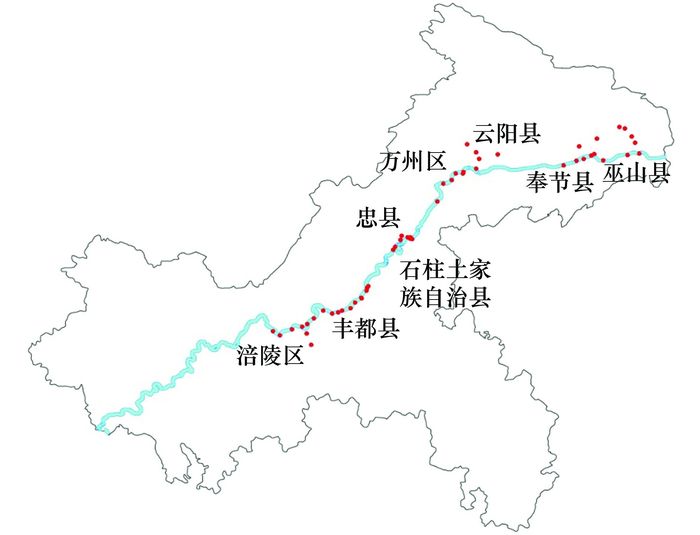
|
图 1 采样位置示意 Fig. 1 Location of the sampling sites |
将土壤冷冻干燥, 除去砂石等杂物, 研磨后过100目不锈钢筛, 准确称取10 g样品, 用200 mL丙酮/正己烷混合溶剂(1:1, 体积比)于60℃索氏抽提24 h, 提取液中加入活性铜片除硫.提取液用旋转蒸发仪浓缩至1.0 mL, 转换溶剂为正己烷, 再次浓缩至1 mL, 再经过多层复合硅胶柱纯化, 并用70 mL丙酮/乙酸乙酯混合溶剂(3:7, 体积比)进行洗脱, 洗脱液浓缩至1 mL左右, 转换溶剂为甲醇, 氮吹定容至200 μL.
1.3 仪器分析PAEs的分析仪器为Waters Xevo G2 Q TOF超高效液相色谱仪飞行时间质谱, 质谱分析选用ESI正离子扫描模式, 以MSE模式对待测物进行定性和定量分析. PAEs在ESI正离子源方式下, 生成[M+Na]+离子峰, 将这些母离子作为定性和定量分析时的监测离子. PAEs用ACQUITY BEH C18 (100 mm×2.1 mm i.d., 1.7 μm, Waters Corp, USA)色谱柱进行分离, 采用的流动相为A(乙腈), B(0.1%甲酸水溶液), 流动相梯度洗脱条件(体积比):0 min:25 A, 75 B; 0~3 min:30 A, 70 B; 3~7 min:70 A, 30 B; 7~15 min:90 A, 10 B保持6 min后结束梯度洗脱, 后运行时间5 min; 流速为0.2 mL·min-1, 进样体积为1 μL, 柱温保持40℃.
1.4 质量控制与质量保证在进行样品分析的同时, 进行方法空白、空白加标及样品平行样等质量保证与控制措施.在空白加标中8种PAEs单体(DMP、DEP、BBP、DBP、DIBP、DNOP、DEHP、DNP)的平均回收率为82.1%~93.5%, 而在土壤基质加标中(抽提过), 8种PAEs的平均回收率范围为76%~101%, 相对偏差小于10%;在方法空白中仅有DBP和DIBP检出, 在最后的结果中均经过空白扣除.化合物的定量采用多点校正曲线法, 每个化合物的校正曲线的相关系数均大于0.99.除DBP和DIBP外,
其他6种PAEs的定量限(the limits of quantification, LOQ)被定义为10倍信噪比, 取混合标准曲线第一点溶液进样, 经过逐级稀释使得信噪比为10的浓度作为其定量限, 6种PAEs单体的LOQ范围为0.4~1.6 ng·g-1; 用空白样品中DBP和DIBP的平均含量的3倍标准偏差作为其定量限, 其LOQ分别为3.6 ng·g-1和9.4 ng·g-1, 连续进样5次, 测得相对偏差小于10%.
1.5 健康风险评价模型土壤健康风险分析采用USEPA推荐的模型对PAEs的日均摄入量以及非致癌风险和致癌风险进行评估. PAEs单体中DMP、DEP、DBP和DNOP为非致癌物质而DEHP和BBP为致癌物质, 本研究仅评估了通过非饮食途径(土壤摄入、皮肤接触和呼吸)摄入PAEs, 每种途径的公式如下:
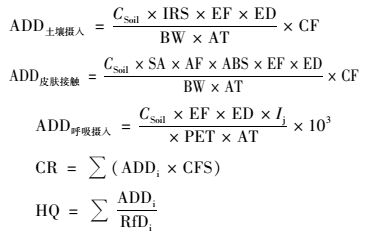
|
式中, ADDi表示非饮食途径日均摄入量, mg·(kg·d)-1; Csoil表示土壤PAEs含量, mg·kg-1; 表 1列出了暴露评价模型参数取值[19].
|
|
表 1 健康风险评价模型参数取值 Table 1 Parameters of the health risk assessment model |
2 结果与讨论 2.1 消落带土壤中PAEs含量水平
在三峡库区消落带土壤样品中均检测到了PAEs, 表明了PAEs在三峡库区环境中已普遍存在. 在8个消落带河段中, ΣPAEs的含量范围为322.0~737.3 ng·g-1, 平均值为497.2 ng·g-1, 对于DBP和DIBP, 其在8个消落带河段中的平均含量范围分别为106.4~255.2 ng·g-1和113.8~303.7 ng·g-1, 均值分别为176.8和202.4 ng·g-1.位于中上游的万州(WZ)采样点PAEs污染水平最高(图 2), 平均含量为737.3 ng·g-1, WZ点位于人群较为集中的城区河流旁, 在此区域, 人为活动较为集中, 特别是交通密度高, 汽车尾气排放都是造成PAEs较高的原因[20], 此外, 在采样点周围聚集了少量的食品生产厂和包装厂, 而PAEs正是这些产业的主要原材料之一, 工厂通过污水排放而将污染物排入河流中从而导致该地区的PAEs污染.位于下游的采样点巫山(WS)污染水平较低, 这可能是由于这一河段两岸是农业生产区, 远离了工业生产区和城市生活区, 其PAEs的来源主要是靠大气的长距离迁移以及干湿沉降.与其他地区土壤PAEs的污染研究相比, 本研究区域中PAEs的浓度与南昌农田土壤、南京地膜覆盖土壤,以及英国、荷兰和丹麦地区的土壤处于同一数量级[21~24], 但明显低于广州城市土壤和垃圾填埋区土壤含量[19, 25].根据我国《农用地土壤环境质量标准(征求意见稿)》中规定, PAEs总量不得超过10.0 μg·g-1, 本研究中8个消落带河段土壤中的PAEs总量均未超过该标准, 但对于研究土壤中DBP, 含量范围为106.4~255.2 ng·g-1, 平均含量为176.8 ng·g-1, 显著高于美国土壤PAEs控制含量(DBP≤ 0.081 μg·g-1)[7], 可见作为一种脆弱生态系统, 三峡库区消落带PAEs的污染风险更应该得到广泛而急迫的关注.
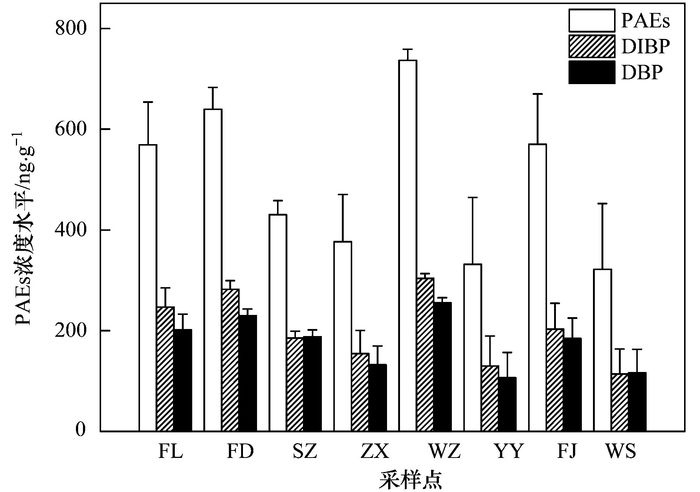
|
图 2 8个消落带河段土壤PAEs浓度水平 Fig. 2 Concentrations of PAEs in soils of the fluctuating zone |
本研究检测分析了8种PAEs单体, DBP、DIBP、DEHP和DNP在所有消落带土壤样品中均有检出, 检出率为100%, 其他主要的单体DMP、DEP和BBP的检出率范围为53.8%~59.6%, 而DNOP仅在10个土壤样品中检出, 检出率为19.2%. 8个消落带河段土壤中PAEs异构体组成情况如图 3所示, DIBP是丰度最高的同系物单体, 其质量贡献率为35.6%~44.1%, 平均值为40.4%, 其次是DBP和DEHP, 分别占ΣPAEs的35.7%和18.5%, 三者平均贡献率为94.5%, 表明在本研究中, DIBP、DBP和DEHP是PAEs最主要的污染物, 这也与已有报道的结果相一致[14], 但对于DEHP在土壤中的组成与文献有差异.在塑料回收加工区域土壤的研究中发现DEHP是最主要的单体, 占总PAEs的68.8%(质量分数)[19]此外在广州城市土壤以及南京农膜土壤中都发现DEHP是最主要的PAEs单体, 均占到总PAEs含量的80%以上[22, 25].但在其他地区的农业土壤中也有发现DBP是最主要的PAEs单体, 其平均质量分数为70%[14].由于消落带土壤处于干湿交替的状态, 环境行为可能与河流沉积物类似, 因此本研究同时也对比了国内外研究中沉积物PAEs的组成特征, 发现在北京某水库沉积物中[26]以及南非河流沉积物[27]和广州河流沉积物中DIBP是最主要的单体[28], 其次是DBP, 而DEHP并不是最主要污染物, 其组成与本研究类似.在本研究中, 消落带土壤性质与一般农业或者城市土壤不同, 消落带土壤每年有6个月时间处于淹水状态, 因此消落带土壤中的PAEs单体极有可能向周围水体释放.已有研究预示了在一定条件下, PAEs向周围环境如水体和大气释放的可能[4], 也有研究模拟了不同环境条件对三峡库区消落带土壤中DBP向水体释放的影响, 证实了消落带土壤向水体快速释放DBP[29], 然而该研究并未模拟DEHP的释放情况, 但在关于三峡库区消落带水体的PAEs污染研究中发现在万州、开县和巫山这3个河段的DEHP是最主要污染物, 呈现较高的浓度, 所造成的健康风险也最大[18].因此, 在淹水状态下消落带土壤向水体释放DEHP可能是导致本研究中DEHP并不是主要污染物的原因.此外, DEHP在土壤微生物中降解也不能完全排除, 有研究发现DEHP在东北黑土中的降解速率高于在褐潮土的速率, 这是由于相较于褐潮土, 黑土中微生物群落更多[4].本研究并未同时采集水样以及探讨消落带土壤中微生物对DEHP降解的影响, 因此对于以上两种因素对消落带土壤DEHP迁移转化的影响在今后的研究中应更加深入和全面地探讨.
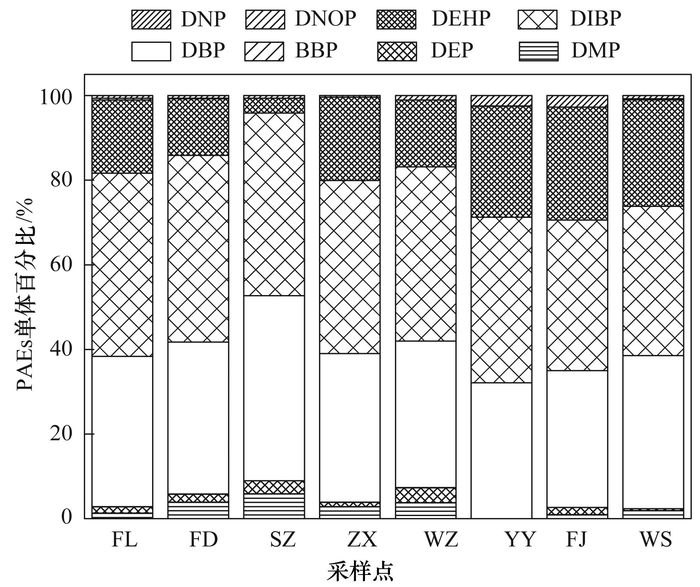
|
图 3 消落带土壤PAEs百分比组成 Fig. 3 Profiles of PAEs in soils of the fluctuating zone |
由于DNOP的检出率较低, 本研究通过SPSS 14.0对三峡库区消落带土壤其他7种PAEs含量进行相关分析, 结果如表 2所示, 其中DMP、DEP、DBP和DIBP两两之间具有较好的相关性, 呈显著性正相关, 表明4种PAEs可能具有相同来源. BBP仅与DEP呈现显著性相关性, 而DNP仅与DNOP相关, 表明BBP、DNP和DNOP的来源与其他几种PAEs不同.为了深层次揭示三峡库区消落带土壤PAEs组成特征以及其来源的内在联系, 本研究利用主成分分析法识别污染物来源.主成分分析结果如图 4所示, 在消落带土壤中, 8种PAEs单体可以由2个主成分反映62.5%, 第一主成分的贡献率为43.5%, 其中DBP、DIBP、DMP和DEP有较高的正载荷.从表 2消落带土壤中PAEs各单体之间的相关关系可知, DMP、DEP、DBP和DIBP两两之间具有极显著正相关, 从而判断这4种单体具有相似的来源.已有的研究证实了DMP和DEP通常用于个人护理品、化妆品、涂料特殊黏合剂和环氧树脂等工业产品中, 而DBP和DIBP主要与增塑剂有关[20], 由此推断, 第一主成分主要反映了三峡库区消落带土壤中PAEs的主要来源于以上两种途径.第二主成分的贡献率为19.0%, DNP和DEHP呈现出较高的正载荷, 与其他单体有较大区别, 并且DNP与DEHP也呈现极显著的相关关系, 说明它们具有相同的来源和相似的环境行为. DNP和DEHP都广泛存在于塑料制品、室内装饰材料和食品里面[20], 由此推测, 第二主成分主要来源于当地的人为活动.
|
|
表 2 消落带土壤7种PAEs相关关系1) Table 2 Correlations of PAEs in soils of the fluctuating zone |
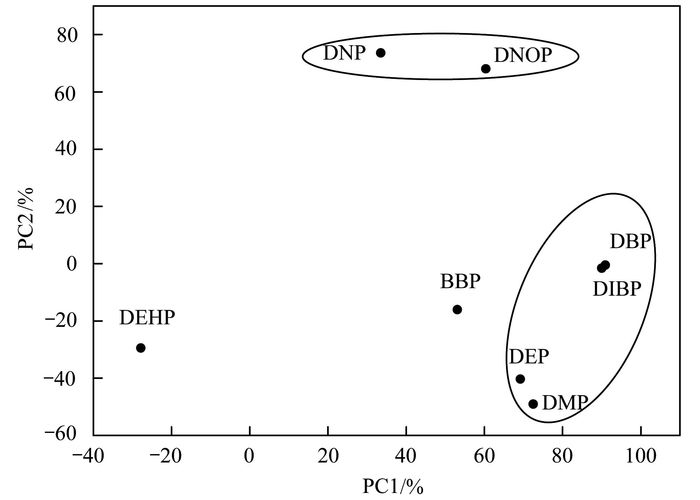
|
图 4 PAEs单体主成分分析因子载荷值 Fig. 4 Factor loadings of PAE congeners by PCA |
本研究仅选取了美国EPA和欧盟优先控制的6种PAEs进行人体健康风险评价, 表 3给出了儿童和成人在不同暴露途径下对土壤中的PAEs的日均摄入剂量, 从中可以看到消落带土壤中不同种类PAEs人均摄入量从高到低依次为DBP、DEHP、DMP、DEP、DNOP和BBP, 暴露剂量均低于美国EPA规定的口服参考剂量(RfD),说明人群暴露消落带土壤中的6种PAEs均未超标.对于成人, 6种PAEs单体主要暴露途径是通过呼吸摄入, 其次是皮肤接触, 最后是经口摄入; 对于儿童, 最主要的暴露途径是经口摄入, 其次是呼吸和皮肤接触.经风险评估模型计算, 成人和儿童对DBP、DMP、DEP和DNOP暴露的非致癌风险HQ值均小于1, 对于DEHP和BBP两类可能表现出致癌风险的PAEs, 同时通过计算致癌风险CR值, 发现DEHP和BBP在成人和儿童中均小于1.0×10-6, 均未超过EPA推荐的致癌风险接受水平[30], 表明消落带土壤PAEs污染对人体不会产生危害.在本研究中, 由于仅考虑了人群在耕作环境时通过土壤介质而产生的健康风险, 并未同时考虑食物富集、饮食等途径产生的风险, 因此导致本研究所评估的PAEs致癌风险低于之前的研究[30].虽然本研究中6种评估PAEs单体的致癌风险均远低于1.0×10-6, 但是DBP的日均摄入量占总PAEs的60%~84%, 此外已有研究证实了一定剂量的DBP对生物生殖发育具有明显毒性作用[31], 此外Swan等[32]和Caldwell等[33]研究表明DBP及其代谢产物具有潜在的基因毒性和致癌风险, 孕妇在预产期前后频繁暴露于PAEs导致莱氏细胞发育受阻和功能受损, 导致新生儿性别变异[34].因此, 在三峡库区消落带耕作过程中应预防DBP带来的潜在健康风险.
|
|
表 3 儿童和成人对PAEs的日均摄入量1)/mg·(kg·d)-1 Table 3 ADD values of PAEs for toddlers and adults via different exposure pathways/mg·(kg·d)-1 |
3 结论
三峡库区消落带土壤样品中8种PAEs均有不同程度检出, 表明了PAEs在三峡库区土壤环境中已普遍存在.在8个消落带河段中, ΣPAEs的含量范围为322.0~737.3 ng·g-1, 与国内外土壤介质中PAEs污染水平比较, 本研究消落带土壤中PAEs属于较低水平; DIBP是最主要的PAEs单体, 其次是DBP, 而DEHP仅占ΣPAEs的18.5%, 这可能是由于在淹水状态下消落带土壤向水体释放DEHP, 从而导致本研究中DEHP并不是主要污染物的原因.此外DEHP在土壤微生物中降解也不能完全排除; 通过相关性分析和主成分分析发现DMP、DEP、DBP和DIBP具有极显著两两正相关关系, 其来源可能与个人护理品、化妆品和增塑剂使用有关; PAEs健康风险评估结果显示, 人群暴露6种PAEs的日均摄入量均未超过美国EPA规定的参考剂量(RfD), 并且6种PAEs单体的致癌风险均远低于美国EPA规定的可接受致癌风险值1.0×10-6, 但是DBP的日均摄入量占总PAEs的60%~84%, 因此, 在三峡库区消落带耕作过程中应预防DBP带来的潜在健康风险.
| [1] | Heudorf U, Mersch-Sundermann V, Angerer J. Phthalates: toxicology and exposure[J]. International Journal of Hygiene and Environmental Health, 2007, 210(5): 623-634. DOI:10.1016/j.ijheh.2007.07.011 |
| [2] | Cai Q Y, Mo C H, Wu Q T, et al. The status of soil contamination by semivolatile organic chemicals (SVOCs) in China: a review[J]. Science of the Total Environment, 2008, 389(2-3): 209-224. DOI:10.1016/j.scitotenv.2007.08.026 |
| [3] | Cai Q Y, Mo C H, Wu Q T, et al. Polycyclic aromatic hydrocarbons and phthalic acid esters in the soil-radish (Raphanus sativus) system with sewage sludge and compost application[J]. Bioresource Technology, 2008, 99(6): 1830-1836. DOI:10.1016/j.biortech.2007.03.035 |
| [4] | Xu G, Li F S, Wang Q H. Occurrence and degradation characteristics of dibutyl phthalate (DBP) and di-(2-ethylhexyl) phthalate (DEHP) in typical agricultural soils of China[J]. Science of the Total Environment, 2008, 393(2-3): 333-340. DOI:10.1016/j.scitotenv.2008.01.001 |
| [5] | Langer S, Weschler C J, Fischer A, et al. Phthalateand PAH concentrations in dust collected from Danish homes and daycare centers[J]. Atmospheric Environment, 2010, 44(19): 2294-2301. DOI:10.1016/j.atmosenv.2010.04.001 |
| [6] | Rudel R A, Perovich L J. Endocrine disrupting chemicals in indoor and outdoor air[J]. Atmospheric Environment, 2009, 43(1): 170-181. DOI:10.1016/j.atmosenv.2008.09.025 |
| [7] | U.S. EPA. Toxic and priority pollutants under the clean water act[EB/OL]. http://water.epa.gov/scitech/methods/cwa/pollutants.cfm. |
| [8] | Directive 2005/84/EC of the European Parliament and of the Council of 14 December 2005 Amending for the 22nd time Council Driective 76/769/EEC on the approxmimation of the laws regulations and administrative provisions of the Member Slates relating to restrictions on the marketing and use of certain dangerous substances and preparations (phthalates in toys and childcare articles)[J]. Official Jurnal of the European Union, 2005, L344: 40-43. |
| [9] | 周文敏, 付德黔, 孙宗光. 中国水中优先控制污染物黑名单的确定[J]. 环境科学研究, 1991, 4(6): 9-12. |
| [10] | Wang X K, Tao W, Xu Y, et al. Indoor phthalate concentration and exposure in residential and office buildings in Xi'an, China[J]. Atmospheric Environment, 2014, 87: 146-152. DOI:10.1016/j.atmosenv.2014.01.018 |
| [11] | Dargnat C, Teil M J, Chevreuil M, et al. Phthalate removal throughout wastewater treatment plant: case study of Marne Aval station (France)[J]. Science of the Total Environment, 2009, 407(4): 1235-1244. DOI:10.1016/j.scitotenv.2008.10.027 |
| [12] | Net S, Dumoulin D, El-Osmani R, et al. Case study of PAHs, Me-PAHs, PCBs, phthalates and pesticides contamination in the Somme River water, France[J]. International Journal of Environmental Research, 2014, 8(4): 1159-1170. |
| [13] | Gao D W, Li Z, Wen Z D, et al. Occurrence and fate of phthalate esters in full-scale domestic wastewater treatment plants and their impact on receiving waters along the Songhua River in China[J]. Chemosphere, 2013, 95: 24-32. |
| [14] | Net S, Sempéré R, Delmont A, et al. Occurrence, fate, behavior and ecotoxicological state of phthalates in different environmental matrices[J]. Environmental Science & Technology, 2015, 49(7): 4019-4035. |
| [15] | Chou K, Wright R O. Phthalates in food and medical devices[J]. Journal of Medical Toxicology, 2006, 2(3): 126-135. DOI:10.1007/BF03161027 |
| [16] |
周永娟, 仇江啸, 王姣, 等. 三峡库区消落带生态环境脆弱性评价[J]. 生态学报, 2010, 30(24): 6726-6733. Zhou Y J, Chou J X, Wang J, et al. Assessment of eco-environmental vulnerability of water-level fluctuation belt in Three-Gorges Reservoir area[J]. Acta Ecologica Sinica, 2010, 30(24): 6726-6733. |
| [17] |
刘丽琼, 魏世强, 江韬. 三峡库区消落带土壤重金属分布特征及潜在风险评价[J]. 中国环境科学, 2011, 31(7): 1204-1211. Liu L Q, Wei S Q, Jiang T. Distribution of soil heavy metals from water-level-fluctuating zone in Three-Gorge Reservoir Area and their evaluation of potential ecological risk[J]. China Environmental Science, 2011, 31(7): 1204-1211. |
| [18] |
许川, 舒为群, 罗财红, 等. 三峡库区水环境多环芳烃和邻苯二甲酸酯类有机污染物健康风险评价[J]. 环境科学研究, 2007, 20(5): 57-60. Xu C, Shu W Q, Luo C H, et al. Water environmental health risk assessment of PAHs and PAEs in the three gorges reservoir[J]. Research of Environmental Sciences, 2007, 20(5): 57-60. |
| [19] |
王昱文, 柴淼, 曾甯, 等. 典型废旧塑料处置地土壤中邻苯二甲酸酯污染特征及健康风险[J]. 环境化学, 2016, 35(2): 364-372. Wang Y W, Chai M, Zeng N, et al. Contamination and health risk of phthalate esters in soils from a typical waste plastic recycling area[J]. Environmental Chemistry, 2016, 35(2): 364-372. DOI:10.7524/j.issn.0254-6108.2016.02.2015072005 |
| [20] | ŠkrbiDć B D, Ji Y, -Duriši Dć -Mladenovi Dć N, et al. Occurence of the phthalate esters in soil and street dust samples from the Novi Sad city area, Serbia, and the influence on the children's and adults' exposure[J]. Journal of Hazardous Materials, 2016, 312: 272-279. DOI:10.1016/j.jhazmat.2016.03.045 |
| [21] |
熊鹏翔, 龚娴, 邓磊. 南昌市农田土壤和水样中邻苯二甲酸酯污染物的分析[J]. 化学通报, 2008, 71(8): 636-640. Xiong P X, Gong X, Deng L. Analysis of PAE pollutants in farm soil and water samples in Nanchang City[J]. Chemistry, 2008, 71(8): 636-640. |
| [22] | Ma T T, Wu L H, Chen L K, et al. Phthalate esters contamination in soils and vegetables of plastic film greenhouses of suburb Nanjing, China and the potential human health risk[J]. Environmental Science and Pollution Research, 2015, 22(16): 12018-12028. DOI:10.1007/s11356-015-4401-2 |
| [23] | Peijnenburg W J G M, Struijs J. Occurrence of phthalate esters in the environment of the Netherlands[J]. Ecotoxicology and Environmental Safety, 2006, 63(2): 204-215. DOI:10.1016/j.ecoenv.2005.07.023 |
| [24] | Vikelsøe J, Thomsen M, Carlsen L. Phthalates and nonylphenols in profiles of differently dressed soils[J]. Science of the Total Environment, 2002, 296(1-3): 105-116. DOI:10.1016/S0048-9697(02)00063-3 |
| [25] | Zeng F, Cui K Y, Xie Z Y, et al. Distribution of phthalate esters in urban soils of subtropical city, Guangzhou, China[J]. Journal of Hazardous Materials, 2009, 164(2-3): 1171-1178. DOI:10.1016/j.jhazmat.2008.09.029 |
| [26] | Zheng X X, Zhang B T, Teng Y G. Distribution of phthalate acid esters in lakes of Beijing and its relationship with anthropogenic activities[J]. Science of the Total Environment, 2014, 476-477: 107-113. DOI:10.1016/j.scitotenv.2013.12.111 |
| [27] | Fatoki O S, Bornman M, Ravandhalala L, et al. Phthalate ester plasticizers in freshwater systems of Venda, South Africa and potential health effects[J]. Water SA, 2010, 36(1): 117-125. |
| [28] | Zeng F, Cui K Y, Xie Z Y, et al. Occurrence of phthalate esters in water and sediment of urban lakes in a subtropical city, Guangzhou, South China[J]. Environment International, 2008, 34(3): 372-380. DOI:10.1016/j.envint.2007.09.002 |
| [29] |
王法, 王强, 木志坚, 等. 三峡库区消落带土壤邻苯二甲酸二丁酯静态释放特征[J]. 环境科学, 2015, 36(7): 2453-2458. Wang F, Wang Q, Mu Z J, et al. Static migration and release of Dibutyl-phthalate in the fluctuating zone of three gorges reservoir[J]. Environmental Science, 2015, 36(7): 2453-2458. |
| [30] | Xia X H, Yang L Y, Bu Q W, et al. Levels, distribution, and health risk of phthalate esters in urban soils of Beijing, China[J]. Journal of Environmental Quality, 2011, 40(5): 1643-1651. DOI:10.2134/jeq2011.0032 |
| [31] | Newbold R. Cellular and molecular effects of developmental exposure to diethylstilbestrol: implications for other environmental estrogens[J]. Environmental Health Perspectives, 1995, 103(S7): 83-87. |
| [32] | Swan S H. Environmental phthalate exposure in relation to reproductive outcomes and other health endpoints in humans[J]. Environmental Research, 2008, 108(2): 177-184. DOI:10.1016/j.envres.2008.08.007 |
| [33] | Caldwell J C. DEHP: Genotoxicity and potential carcinogenic mechanisms—A review[J]. Mutation Research/reviews in Mutation Research, 2012, 751(2): 82-157. DOI:10.1016/j.mrrev.2012.03.001 |
| [34] | Main K M, Mortensen G K, Kaleva M M, et al. Human breast milk contamination with phthalates and alterations of endogenous reproductive hormones in infants three months of age[J]. Environmental Health Perspectives, 2006, 114(2): 270-276. DOI:10.1289/ehp.8075 |
| [35] | NMED (New Mexico Environment Department). Technical background document for development of soil screening levels[S]. |
 2017, Vol. 38
2017, Vol. 38


